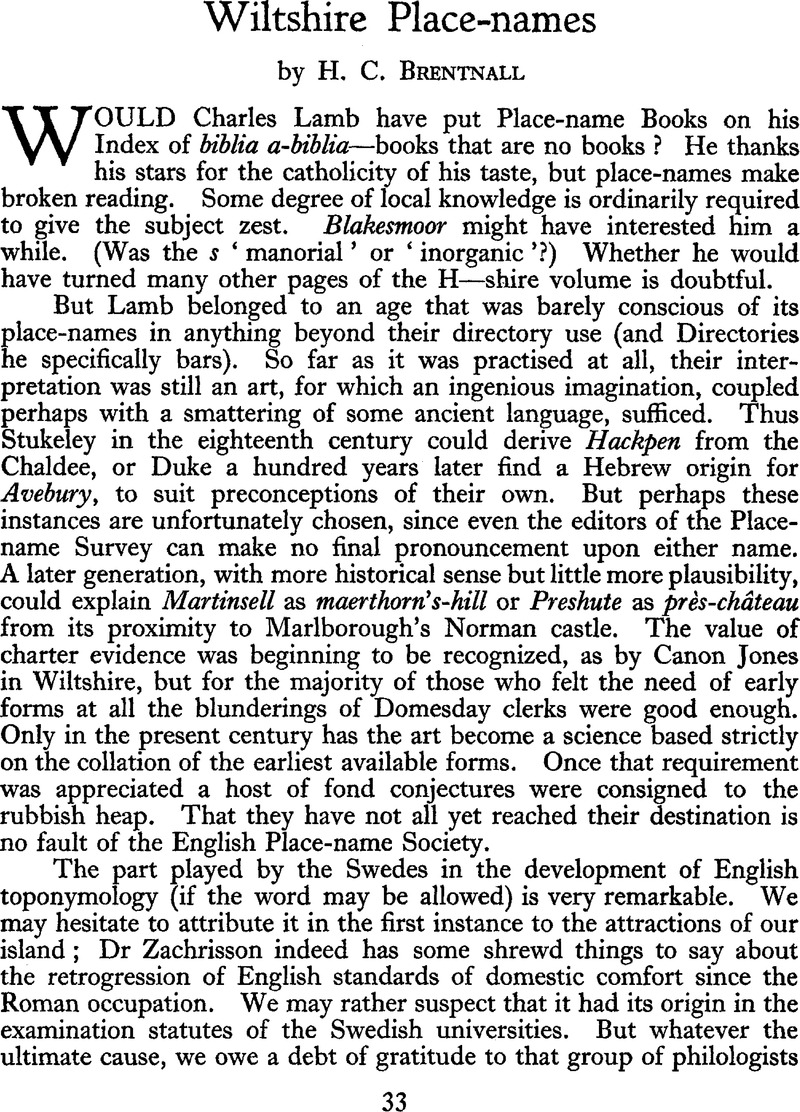Article contents
Wiltshire Place-names
Published online by Cambridge University Press: 02 January 2015
Abstract

- Type
- Research Article
- Information
- Copyright
- Copyright © Antiquity Publications Ltd 1941
References
1 ENGLISH PLACE-NAME SOCIETY, volume XVI. The Place-names of Wiltshire. By J. E. B. Gover, Allen Mawer and F. M. Stenton. Cambridge, at the University Press, 1939. pp. XLI, 547. 22s 6d.
2 Three instances from other counties are quoted in the Introductory volume of the Survey, part I, p. 157 : Black Barrow in Broomy Walk, New Forest, but this is called a tumulus in the one-inch Ordnance map of the Forest ; Black Barrow, Isle of Wight, but, if this is the one in Mottistone, the one-inch map again prints the name in the type reserved for (non-geological) antiquities ; Creech Barrow in Purbeck, which Murray’s Guide described as ‘a conical tertiary hill, almost volcanic in outline, towering above all the other heights’. Here we seem to have the very thing, a natural hill of barrow form—but the Ordnance map shows a tumulus on its crest. Nevertheless there may be genuine instances, and perhaps Charlbury, formerly known as Shalborough, or Skelbarrow Hill is one. Hippisley Cox (Green Roads of England, p. 143) speaks of ‘the three rounded summits of Charbury (sic) Hill, looking like great tumuli’. He seems to include Lammy Down, but on none of these summits does any barrow exist today. Hoare (Anc. Wilts., 11, 46) mentions that several barrows are shown here on old maps of Wiltshire, but that they are really natural mounds. He is probably referring to Andrews and Dury’s map of 1773. Black Barrow in Broomy Walk is a natural hill like King Barrow, near Cripple-style, 6 miles W. by N. of it across the Arm. Both are now correctly shown in ordinary lettering on the 5th edition of the 1-inch O.S. map. Black Barrow in Mottistone is also a natural hill, but there is a large round barrow, formerly unmarked, near it—I write from memory, since my notes and maps are at present inaccessible. There can be no doubt, I think, that beorh, like hlaew, was occasionally applied to natural hills.—O.G.S.C.]
3 The same promontory carries a lesser elevation, in Alton Priors, called Burlinch Hill. This seems to be a hlinc compound which has escaped the editors’ notice.
4 Dr Grundy has analyxed the wics and -weorths of the charters with interesting results (Wilts. Arch. Mag. vol. XLI, p. 344). He shows that, where determinable, 95 per cent. of the -wics have descriptive attributes and 87 per cent, of the -weorths personal ones. The two classes of Wiltshire -burhs cannot be made to give such clear results owing to the difficulty of deciding in many cases whether the settlement was named from an earthwork or the earthwork from a settlement. Nevertheless a tendency is traceable on which a presumption may be tentatively based.
5 A thousand years ago the camp must have belonged to Badbury. The bounds of Liddington and Badbury at that date are discussed in Dr Grundy’s Saxon Land-charters of Wiltshire (1, p. 205 and 2, p. 12), but the interpretation has in parts defeated him They are certainly obscure, but without going into details it may be said that the common boundary to the south seems to become intelligible only if it may be taken east of the camp, not west as the present boundary runs. This transfers the camp from Liddington to Badbury.
6 This alternative is interesting. It seems to show a change resultant upon the occupation of the camp by the founder of Bilbury Farm. He may have been a Billa as Mr Young suggests (Origins of the West Saxon Kingdom, p. 32), but the possibility of a Biwiliburh from Biwili, the old name of the Wylye land-unit, must not be overlooked.
7 Grundy, op. cit., 1, p. 204. They seem also to have missed his valuable list of Wiltshire place-names, quoted above in note 4. Some of his suggestions there might perhaps have been considered.
8 Roman Britain and the English Settlements, p. 401, footnote
9 The siege is usually represented as a siege of the Saxons by the Britons, but nothing in Gildas, the earliest authority, or in the best texts of Nennius, forbids us to suppose that the obsessio was of Britons by Saxons.
- 1
- Cited by




